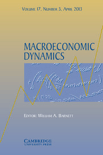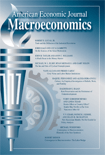
Computational Economics
metrics 2024
Innovating Economic Insights through Computational Excellence.
Introduction
Computational Economics is a premier journal dedicated to advancing the interdisciplinary field that bridges computational methods and economic theory. Published by Springer in the Netherlands, this journal serves as a critical platform for researchers and practitioners from economics, econometrics, and computer science, fostering innovation and cross-pollination of ideas from 1993 to 2024. With a notable impact factor in its categories—ranking Q2 in Economics, Econometrics, and Finance and Q3 in Computer Science Applications—Computational Economics consistently delivers rigorous peer-reviewed research that addresses contemporary challenges in economic modeling and computational techniques, making it an indispensable resource for the academic community. The journal provides a range of access options and is indexed in Scopus, where it holds a strong position in the 78th percentile of its category, ensuring high visibility and engagement for published works. Researchers, students, and professionals will find valuable insights across its diverse scope, facilitating the exploration of new methodologies that shape the future of economic analysis.
Metrics 2024
 0.50
0.50 1.90
1.90 1.80
1.80 47
47Metrics History
Rank 2024
Scopus
IF (Web Of Science)
JCI (Web Of Science)
Quartile History
Similar Journals

ENGINEERING ECONOMIST
Exploring the Financial Dimensions of InnovationENGINEERING ECONOMIST, published by Taylor & Francis Inc, stands as a revered journal in the intersecting fields of economics, engineering, and education, with an ISSN of 0013-791X and E-ISSN of 1547-2701. Since its inception in 1955, this journal has provided a vital platform for researchers, practitioners, and students to disseminate and engage with novel insights and methodologies impacting the engineering economy. With a robust focus on the quantitative aspects of engineering management and decision-making, ENGINEERING ECONOMIST ranks within the Q3 category in multiple disciplines including Economics and Econometrics, Education, and Miscellaneous Engineering as of 2023, reflecting its significant contributions to the scholarly community. The journal’s Scopus rankings further emphasize its relevance, ranking #778 in Education and #158 in General Engineering. Although the journal does not offer Open Access options, it remains pivotal for advancing the dialogue at the nexus of technology and economics, making it an essential resource for anyone interested in the financial dimensions of engineering innovations.

Computational Management Science
Bridging Theory and Practice in Computational ManagementComputational Management Science, published by SPRINGER HEIDELBERG, is a significant journal catering to the intersection of technology, management, and decision sciences. With an ISSN of 1619-697X and E-ISSN 1619-6988, this journal serves as a platform for innovative research focusing on computational methods applied to management science, operations research, and information systems. Based in Germany, the journal spans a critical period from 2005 to 2024, emphasizing trends that shape the future of the field. As a Tier 3 journal in multiple categories including Business, Management, and Accounting, and ranked across various disciplines with Scopus rankings highlighting its relevance, it stands out in fostering scholarly discourse. The journal invites contributions that enhance the application of computational techniques in decision-making, thereby enriching the practices of both academics and industry professionals. While it currently does not offer open access, its influence is reflected in its established readership and community engagement. Researchers, practitioners, and students alike will find in this journal a vital resource for advancing knowledge and sparking innovation in computational management.

Economic Theory Bulletin
Bridging theory and practice for a deeper understanding of economics.Welcome to the Economic Theory Bulletin, a premier journal dedicated to advancing the field of economic theory. Published by SPRINGER HEIDELBERG, this journal serves as a critical platform for researchers and professionals to disseminate innovative ideas and research findings that shape economic discourse. With an ISSN of 2196-1085 and an E-ISSN of 2196-1093, the Economic Theory Bulletin invites contributions that address theoretical advancements and empirical applications in economics, fostering insightful dialogue among scholars. Although the journal operates under a traditional access model, it remains committed to high-quality, peer-reviewed scholarship that meets the rigorous standards of the academic community. The diverse range of articles published here not only contributes to the theoretical foundations of economics but also emphasizes real-world applications, making it an essential resource for students and professionals alike. The journal’s impact on the evolving landscape of economic theory ensures that it remains a vital reference point for the latest research and trends in the field.

Ekonomika i Matematiceskie Metody-Economics and Mathematical Methods
Advancing Economic Insight through Mathematical PrecisionEkonomika i Matematiceskie Metody - Economics and Mathematical Methods is a distinguished journal published by the esteemed Russian Academy of Sciences and the State Academy of Humanities (GAUGN). It serves as a vital resource in the interdisciplinary field of economics and mathematical applications, focusing on advanced theories, methodologies, and quantitative techniques that drive economic research and practice. With an ISSN of 0424-7388, this journal is geared towards researchers, professionals, and students who seek to contribute to the evolving landscape of economic theory and mathematics. Although the journal does not currently offer open access, it remains committed to fostering rigorous academic discourse. Through its insightful articles, Ekonomika i Matematiceskie Metody plays a crucial role in disseminating influential concepts and methodologies, making it an essential publication within the realm of economic sciences.

Quantitative Economics
Transforming economic research with impactful quantitative findings.Quantitative Economics is a leading open-access journal published by WILEY, dedicated to advancing the field of economics through rigorous quantitative analysis. Established in 2010 and based in the United States, this influential journal boasts an impressive Q1 rating in the 2023 category of Economics and Econometrics, reflecting its high impact and quality within the field. With a Scopus ranking of #222 out of 716 in the Economics and Econometrics category, it sits comfortably in the 68th percentile, underscoring its relevance to researchers and professionals alike. The journal accepts a wide range of submissions, including original research articles, methodological advancements, and comprehensive reviews, which contribute to the understanding and application of quantitative methods in economic research. By providing immediate open access to all published articles, Quantitative Economics ensures that vital findings are readily available to academics, policymakers, and students across the globe, enhancing collaboration and innovation within the discipline.

MACROECONOMIC DYNAMICS
Elevating Understanding of Economic Trends and ImpactsMACROECONOMIC DYNAMICS, a distinguished academic journal published by Cambridge University Press, serves as a pivotal platform for innovative research in the fields of economics and econometrics. With its ISSN 1365-1005 and E-ISSN 1469-8056, the journal has been at the forefront of scholarly communication since its inception in 1997, offering an extensive range of articles that explore dynamic economic models, policy impacts, and theoretical advancements through the latest empirical analyses. Currently holding a Q2 ranking within the 2023 Economics and Econometrics category, and positioned at rank #409 out of 716 within Scopus, it is an essential resource for researchers, professionals, and students alike, looking to stay updated on critical developments in macroeconomic theory and practice. Although it follows a traditional subscription model rather than Open Access, the journal continually strives to disseminate high-quality, peer-reviewed content that informs and inspires the global economics community. The importance of MACROECONOMIC DYNAMICS lies in its commitment to fostering a deeper understanding of economic phenomena, making it a must-read for anyone engaged in the complexities of the economic landscape.

American Economic Journal-Macroeconomics
Leading the Way in Macroeconomic ScholarshipAmerican Economic Journal-Macroeconomics, published by the American Economic Association, stands at the forefront of economic research, addressing pivotal macroeconomic issues that shape global economies. With an impressive Scopus rank of #8 out of 288 in its field and a notable 97th percentile ranking, this journal is widely regarded as a top-tier publication, specifically categorized in the Q1 category for Economics, Econometrics, and Finance as of 2023. Operating under ISSN 1945-7707 and E-ISSN 1945-7715, it aims to disseminate high-quality research from 2009 through 2024 and beyond, providing crucial insights into macroeconomic theory and policy. Although the journal currently does not operate under an open access model, it remains a vital resource for researchers, economists, and students seeking to deepen their understanding of macroeconomic dynamics and their implications for economic policy worldwide. The journal's impactful contributions make it an essential read for those striving to influence economic thought and practice.

ECONOMIC THEORY
Elevating Economic Scholarship to New HeightsECONOMIC THEORY is a leading academic journal published by Springer, dedicated to advancing the field of economics through the dissemination of innovative and high-quality research. Established in 1991, this journal has become a crucial resource for researchers, professionals, and students interested in theoretical economics and econometrics. With a strong reputation, it ranks in the Q1 category for Economics and Econometrics as of 2023, exemplifying its influence and contribution to the discourse in the field. The journal operates without Open Access options, ensuring that all published content undergoes rigorous peer-review, maintaining scholarly integrity. Scholars can access the journal's rich compendium of articles that delve into diverse economic theories, providing invaluable insights and fostering academic dialogue. Headquartered in Germany, ECONOMIC THEORY is committed to shaping the future of economic research and serving as a cornerstone in the academic community.

NETWORKS & SPATIAL ECONOMICS
Unraveling the Complexities of Economic NetworksNETWORKS & SPATIAL ECONOMICS, published by SPRINGER, stands at the forefront of research within the disciplines of artificial intelligence, computer networks, and software engineering. With an ISSN of 1566-113X and E-ISSN 1572-9427, this esteemed journal boasts an impressive impact factor and is recognized in the Q2 and Q3 quartiles in its respective categories for 2023. As a vital resource for researchers and professionals, it offers a dynamic platform for disseminating innovative findings that explore the intersections of spatial economics and network theory. The journal has evolved significantly since its inception in 2005, with its convergence period extending to 2024, showcasing its commitment to advancing scholarly discourse and providing access to critical advancements in the field. Aimed at academics, practitioners, and students alike, NETWORKS & SPATIAL ECONOMICS is essential for anyone seeking to deepen their understanding of how spatial frameworks and network dynamics influence economic systems.

Econometrics
Fostering Dialogue in the World of EconomicsEconometrics, published by MDPI, is a prominent open access journal based in Switzerland, dedicated to advancing research in the fields of economics and econometrics. Since its inception in 2013, this journal has been pivotal in disseminating innovative theories and empirical findings, fostering an engaging dialogue among scholars and practitioners. With an impressive Q2 ranking in the 2023 category of Economics and Econometrics and a solid position at #378 out of 716 in Scopus rankings, it stands as a vital resource for those seeking to enhance their understanding and application of econometric methods. The journal offers immediate open access to its published articles, ensuring that researchers, professionals, and students alike can easily access and contribute to the evolving body of knowledge in this essential discipline. The scope of Econometrics encourages submissions that cover a broad array of topics, making it a dynamic platform for innovative research until 2024 and beyond.